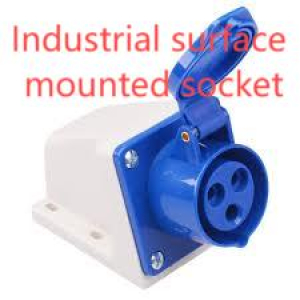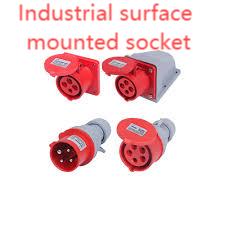Choosing the correct Industrial surface mounted socket at the specification stage avoids costly retrofits, and installing the recommended Industrial surface mounted socket in the proper orientation ensures sealing, accessibility, and electrical safety without surprises. Early coordination between electrical designers, structural teams, and maintenance planners helps define the mounting substrate, expected mechanical stresses, ingress requirements, and spare-part strategies that drive an enclosure’s long-term reliability. Bringing those stakeholders together at concept stage reduces rework and supports predictable lifecycle costs.
Site assessment and mounting substrate analysis
Begin by mapping every installation location and documenting substrate type, expected mechanical impacts, and environmental exposures. Surface mounted sockets attached to metal cladding, concrete, timber, or lightweight facades each need distinct anchor strategies and backing plates. Consider vibration, pedestrian or vehicle impact risk, and potential tamper or vandal exposure. A detailed site matrix that includes spray directions for washdowns, salt-air exposure levels, and thermal cycling helps narrow suitable product families and fastening systems.
Material selection and corrosion-resistant detailing
Material choices strongly influence service life. In aggressive or coastal atmospheres, choose stainless-steel enclosures or properly treated aluminum with compatible fasteners to avoid galvanic corrosion. For lightweight applications, engineered polymers with UV stabilizers provide a cost-effective alternative where chemical exposure is limited. Specify surface preparation and certified coating systems rather than relying solely on topcoat warranties; primer and pre-treatment quality dramatically extend cosmetic and protective lifespans. Inside the box, plated terminals and corrosion-resistant screws ensure reliable electrical continuity over time.
Sealing strategies, cable entry and strain relief best practices
True weather resistance depends less on a single rating and more on correct cable entry design. Use removable gland plates and partitioned entries so future cables can be added without cutting new holes. Select gland elastomers compatible with local chemicals and temperature ranges, and specify replaceable gasket channels to simplify field renewal. Proper strain relief reduces mechanical stress on seals and terminals; always maintain minimum bend radii and secure conductors away from the sealing faces to prevent compression loss over service cycles.
Nante product modularity and retrofit-ready options
Look for enclosure platforms that accommodate modular inserts and quick-change mounting plates—features that simplify servicing and upgrades. Nante’s surface-mounted families include removable front bezels, pre-bench-tested gland modules, and interchangeable internal rails for surge arrestors or monitoring devices. Choosing a modular approach lets teams add protection modules or communications gear without creating new penetrations that would jeopardize ingress integrity. Factory-fitted modules and clear assembly drawings minimize on-site modifications and shorten commissioning time.
Installation, commissioning, and maintenance protocols
A high-spec socket will still fail if installed incorrectly. Create commissioning checklists that verify uniform gasket compression, confirm terminal torque values, and validate correct gland sizing. Record installation parameters—gland types, torque settings, mounting orientation—so future maintenance replicates the original condition. Use a practical ingress verification (controlled spray or visual inspection) after installation and schedule periodic checks focused on seal condition, fastener security, and thermal imaging to spot high-resistance connections before failure.
Thermal layout, electrical segregation and safety considerations
Plan internal layouts so heat sources are isolated from temperature-sensitive electronics, and provide conductive mounting paths or spreaders to remove heat to the chassis. Maintain segregation between power and control circuits to reduce interference and ensure clearances meet relevant codes. Include space for surge protection and, where appropriate, metering or remote monitoring to facilitate condition-based maintenance without modifying the enclosure later.
Spare parts, logistics and lifecycle cost analysis
Standardize on a limited family of gland plates, gaskets, and fasteners across projects to simplify stocking and reduce mean time to repair. Maintain a small onsite kit with common parts to expedite emergency repairs. When evaluating procurement options, compare total cost of ownership—including likely maintenance intervals, spare lead times, and supplier support—rather than focusing exclusively on upfront unit price.
Choosing an industrial surface-mounted socket system that matches the mounting environment, material needs, and service expectations results in safer, longer-lasting installations. For product families, detailed datasheets, and configurator tools, visit www.nante.com


